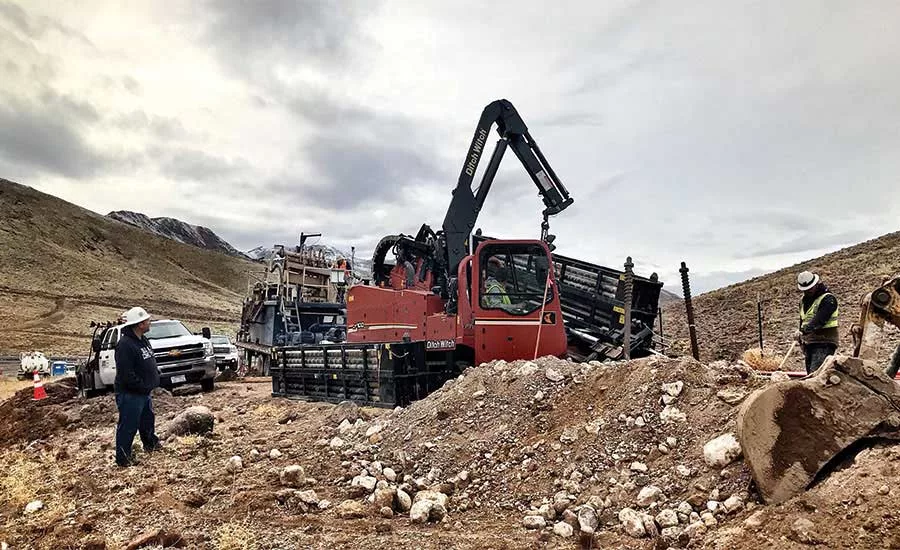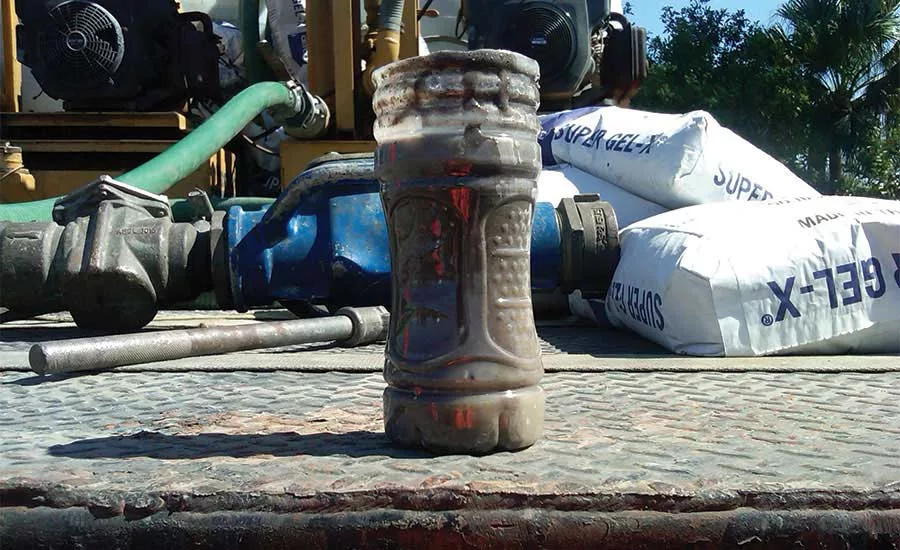HDD Drilling Fluids and the Need for Gel Strength

Really tough soil conditions, like gravel and cobble, may require mixed metal oxide (MMO) products to bolster the gel strength of the drilling fluids.
Source: CETCO Drilling Products photos

As children digging in the dirt, one of the most basic lessons one learns is that in order to make a hole in the ground, dirt must be removed. Kids may accomplish the removal of dirt by means of makeshift tools such as sticks, bare hands, or even utensils pirated from mom’s kitchen — but the concept and goal of removing dirt to make a hole in the ground becomes clear and concise. Horizontal directional drilling (HDD) contractors must keep this basic concept in mind when drilling a bore to install a product line underground. Drilling fluid is not only a tool we use to cool and lubricate the bit and drill string and to stabilize the borehole. It’s also a tool for conveying dirt or drill cuttings out of the ground in order to make a borehole opening large enough to pull product line through. Gel strength is one of the most important characteristics of an HDD drilling fluid, and understanding how to test for gel strength and adjust drilling fluids to varying soil conditions can greatly increase the success rate for HDD contractors.
Drilling fluids are non-Newtonian fluids because viscosity changes with shear/movement as opposed to a Newtonian fluid, like water or oil, where viscosity changes with temperature. The faster a drilling fluid moves, the lower the viscosity, and when a drilling fluid is static, it forms gels to keep drill cuttings in suspension. Gel strength is a measure of the electrochemical forces in a drilling fluid when it’s static, and it is these electrochemical forces that enable drilling fluid to suspend drill cuttings and transport cuttings to the surface. Bentonite platelets have a negative electrostatic charge in the surface of the platelets and a negative charge on the ends of the plates, which creates gel strength and viscosity. Synthetic polymer — like the type commonly used to control/inhibit reactive clays — has little to no gel strength/suspension, which is why bentonite is recommended even when drilling through clay formations.
Many people confuse gel strength with viscosity, which can be defined as the resistance of a drilling fluid to flow. In actuality, the ideal drilling fluid for any application will perform all of the functions required, such as suspending and transporting drill cuttings to the surface, at the lowest viscosity in order to reduce the annular pressures that can lead to frackouts. Two fluids can have the same viscosity, yet be totally different in their ability to suspend and transport drill cuttings to the surface.
In vertical drilling applications, the flow of drilling fluid is in the opposite direction of where gravity is trying to take the drill cuttings, therefore it is much easier to convey drill cuttings out of the borehole. Basically, by moving the drill cuttings faster than the settling rate, the hole can be kept clean. Annular ascending rates for water well drilling range from 85 to 125 feet per minute, whereas flow rates are much lower in HDD applications where return flow is perpendicular to gravitational pull. In HDD drilling applications, drill cuttings have only inches to fall before they hit the bottom of the borehole. Most HDD specialty bentonite drilling fluid products have much higher gel strengths than high-yield bentonite.
The most common way of testing for gel strength is with a fan rheometer where the gel strength is tested when the drilling fluid is at rest for 10 seconds and then for 10 minutes. A cheaper alternative method for testing gel strength is to use a shearometer, which is basically a metal reservoir with a measuring stick in the middle. A weighted sleeve is placed over the measuring stick down to the fluid and released at the same time a stopwatch is started.
For drilling contractors out in the field, the easiest way to determine if the drilling fluid has sufficient gel strength needed to remove drilling cuttings from a horizontal directional bore is to use a clear container (a water bottle with the top cut off works great). Pour in the drilling fluid, go to the entry or exit pit and grab a handful of the material/soil being drilling into, and stir it onto the sample of drilling fluid. Let it sit for some time (at least an hour or even overnight) and check for settling. Remember, if it settles in the sample, it will settle in the borehole and the contractor will be trying to pull product through a hole full of drill cuttings. This simple test should be done on all HDD projects because it is accurate and can debunk a lot of myths and misconceptions about drilling fluid. This is also a good test when trying alternative drilling fluid products (such as bentonite-free products).
When using a bentonite-based drilling fluid, there are two ways of adjusting the gel strength. It can be increased by adding more bentonite, but this also increases viscosity and annular pressures. Another alternative is to use a gel-strength-enhancing product that will dramatically increase gel strength with a minimal increase in viscosity. The most common product to use in this application is xanthan gum, which is a biodegradable natural polymer (polysaccharide) often used as a thickener in the food and beverage industry. Most drilling fluid manufacturers have this product in a dry powder form, and it can be added to a bentonite drilling fluid after the bentonite has fully yielded. Another alternative is a mixed metal oxide (MMO) product, which takes the shear-thinning principle of drilling fluids to an extreme, and will provide copious amounts of gel strength/suspension while dramatically reducing mud pump/annular pressures. MMO products are great in extreme soil conditions such as gravel and cobble, but are quite different to use and alternative methods of testing may be needed.
Remember, soil must be removed in order to make a hole in the ground, and drilling fluid returns are the means of carrying drill cuttings to the surface. Gel strength is one of the most important qualities of an HDD drilling fluid and, by cup testing as previously described, one can easily determine if a drilling fluid mixture is up to the challenge.
Looking for a reprint of this article?
From high-res PDFs to custom plaques, order your copy today!

